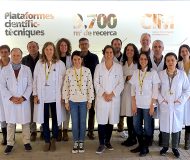

A new study by Sant Pau researchers attached to CIBERDEM and CIBERCV establishes that patients with severe/advanced abdominal aortic aneurysm (AAA) present a significant reduction in the main cardioprotective function of HDLs, their ability to prevent the accumulation of cholesterol in the macrophages of the arterial wall.
The results, published in the journal Biomolecules, were carried out by researchers from CIBERDEM, the Sant Pau Biochemistry Service and the Cardiovascular Risk Metabolic Basis Group of the Sant Pau Research Institute, led by Francisco Blanco-Vaca and Juan Carlos Escolà-Gil from this institute, together with researchers from CIBERCV and the Health Research Institute of the Fundación Jiménez Díaz in Madrid, led by José Luis Martín-Ventura.
As the researchers explain, the functional alteration of HDL was only found when patients had an AAA greater than 5 cm, although HDL cholesterol concentration levels were similar to patients with AAA of intermediate diameter (less than 5 cm). In contrast, HDL function in patients with intermediate-diameter AAA was not significantly reduced when compared to that of healthy people. In addition, these patients were followed for a period of 5 years and their HDL function was found not to predict AAA growth rate or need for surgery. In any case, the experts of CIBERDEM and CIBERCV indicate that studies with more patients will have to be undertaken to corroborate these data.
Identify biomarkers for disease prognosis and monitoring
Abdominal aortic aneurysm (AAA) is a permanent dilation of the abdominal aorta that affects approximately 5% of men over the age of 50 and more than 1% of women over the age of 65. In the most severe cases, rupture of the artery is a major cause of death.
At present, there are no pharmacological treatments that help prevent the progression of AAA. When AAA is greater than 5 cm, surgical intervention is the only therapeutic alternative. The search for biomarkers that contribute to an earlier diagnosis of the disease is a necessary tool for the monitoring and prognosis of the disease.
The researchers Jes Lindholt from Odense University Hospital; Marina Canyelles and Mireia Tondo from the Biochemistry Service of the Hospital de Sant Pau; David Santos and Irati Fernández-Alonso from the Sant Pau Research Institute; David de Gonzalo Calvo from CIBERCV and the Institute of Biomedical Research of Barcelona (IIBB) and Luis Miguel Blanco-Colio from CIBERCV and the Health Research Institute of the Fundación Jiménez Díaz-Universidad Autónoma de Madrid have also participated in the study.
Canyelles, M.; Tondo, M.; Lindholt, J.S.; Santos, D.; Fernández-Alonso, I.; de Gonzalo-Calvo, D.; Blanco-Colio, L.M.; Escolà-Gil, J.C.; Martín-Ventura, J.L.; Blanco-Vaca, F. Macrophage Cholesterol Efflux Downregulation Is Not Associated with Abdominal Aortic Aneurysm (AAA) Progression. Biomolecules 2020, 10, 662.